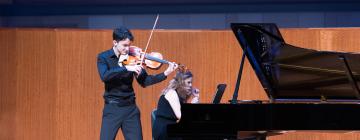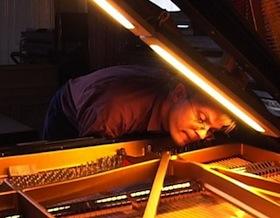
Pianomania (2009) casts a smiling eye on a level of pianistic perfection poised between brilliance and madness. The 93-minute documentary, which opens at San Francisco’s Opera Plaza on Aug. 5, explores the life of the ever-inventive Stefan Knüpfer, whose dedication to his clients’ wishes and whims reveals him as being less a “Steinway piano technician” than a gleeful devotee of artists and music.
The film spends most of its time observing pianist Pierre-Laurent Aimard’s preparation for his Bach recording of Art of Fugue for Deutsche Grammophon. A full year before the recording session, Aimard tells Knüpfer that Bach’s composition calls for four very different sounds. At various times, he believes, the composer intended his music to evoke the sound of a harpsichord, a fortepiano, an organ, and a chamber orchestra. Thus, he asks Knüpfer to continually alter the tonal palette of the modern Steinway — an instrument that Bach never heard — so that different fugues move closer to the sound he believes the aged Bach heard in his head.
Pianomania Trailer
Knüpfer is game. Crawling around and even inside Aimard’s chosen instrument(s) way past midnight, inventing ingenious modifications that will surely make some purists cringe, he sets about his task with all the dedication of a monk or bodhisattva. You wish the middle range to sound more like I’ve gotten the top and bottom to sound? Let’s see if stuffing these little wedges between the strings, or trying these deflectors, will do.
Thanks to directors Lilian France and Robert Cibis, what could have devolved into a one-gimmick movie becomes an ever-engrossing exploration. Thanks to the film’s sound editing, which won top honors at the German Film Awards, we not only see but also hear what two artists on the edge are after.
Aimard is hardly Knüpfer’s only client. Alfred Brendel, Lang Lang, Rudolf Buchbinder, Till Fellner, and Julius Drake (in a moving sequence that also involves tenor Ian Bostridge) all make cameo appearances. As if Aimard’s obsession, and Knüpfer’s mixture of delight and obeisance, were not enough, several extended sequences with the zany violinist Aleksey Igudesman and a laugh-a-minute pianist, Richard Hyung-Ki Joo, provide comic relief. As foils, so to speak, Aimard’s sound engineer Tobias Lehmann and record producer Tobias Claßen do far more than balance levels.
This being a documentary, the musical excerpts tend to be short. Thankfully, only once does an abrupt segue jar. The rest of the time, cutting away at music many consider sacred avoids the descent to the profane.
Pianomania leaves us with lots of unanswered questions. I now find it difficult to listen to recordings of the fabled pianists of yore without wondering whether they were solely responsible for their own uniqueness. Did Rachmaninov, Rubinstein, and all the rest have at their disposal one or more of Knüpfer’s predecessors? Were the instruments of earlier eras even more adaptable to sonic modifications? And just whose touch are we hearing?
Beyond the questions lies the sheer fascination of watching Knüpfer joyfully pursue his unofficial master’s goals. Pianomania has already been named “Best Documentary, San Francisco International Film Festival,” and more awards are on the way. Watch and listen, and you’ll know why.

